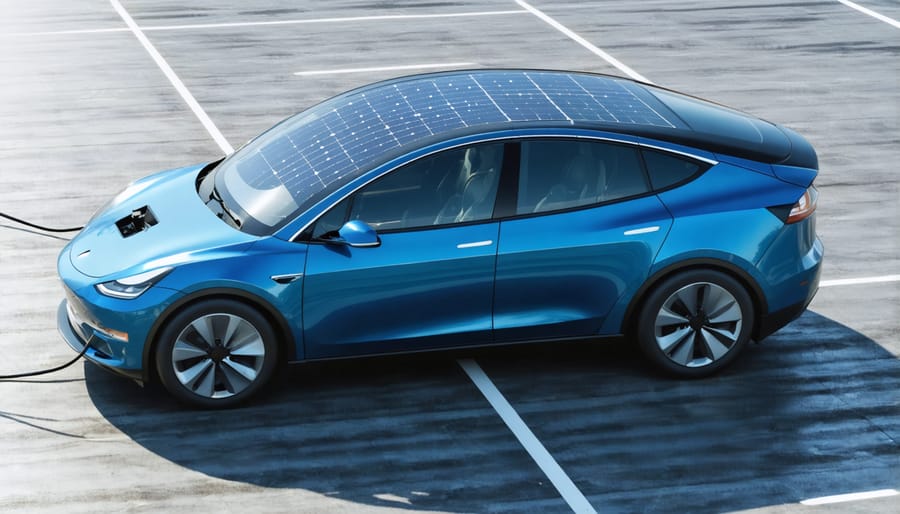Imagine a world where your electric vehicle not only runs on clean energy but also generates its own power from the sun. Solar panels on EVs are the exciting next step in sustainable transportation that could revolutionize how we think about driving. This groundbreaking technology integrates photovoltaic cells into the vehicle’s body, allowing it to harness solar energy to charge the battery while parked or even during motion. With the potential to significantly extend driving range, reduce reliance on the grid, and minimize the environmental impact of EV charging, solar-powered electric vehicles offer a glimpse into a greener, more self-sufficient future of personal mobility.

How Solar Panels on EVs Work
Solar Panel Placement and Design
When it comes to integrating solar panels into the design of electric vehicles, manufacturers typically place them on the roof, hood, or trunk to maximize exposure to sunlight. Some EVs feature solar panels seamlessly integrated into the body design, while others use more noticeable aftermarket panels.
Special design considerations include using lightweight, durable, and flexible solar cells that can withstand the elements and the vibrations of driving. The panels must also be efficiently wired into the EV’s electrical system to charge the battery. Aerodynamics play a role too, as solar panels can slightly impact the vehicle’s drag coefficient.
While solar panels on EVs are still an emerging technology, advancements in solar cell efficiency and design are making them an increasingly viable option for extending range and reducing reliance on charging infrastructure. As the technology improves, we can expect to see more innovative and aesthetically pleasing integrations of solar power into the design of future electric vehicles.
Energy Capture and Storage
Solar panels on EVs harness the power of the sun, converting its energy into electricity that is then solar energy captured and stored in the vehicle’s battery system. This process begins with photovoltaic cells in the solar panels absorbing sunlight and generating direct current (DC) electricity. The DC power is then sent to an inverter, which converts it into alternating current (AC) electricity that is compatible with the EV’s battery. The battery stores this energy for later use, either to power the electric motor directly or to supplement the vehicle’s primary charging source. With advancements in solar technology and battery storage capacity, the potential for solar-powered EVs to reduce reliance on the grid and provide clean, renewable energy for transportation is becoming increasingly viable. As more EVs incorporate solar panels, the benefits of this sustainable energy solution will continue to grow.

Benefits of Solar Panels on EVs
Increased Driving Range
Solar panels can significantly extend an EV’s driving range by converting sunlight into electricity to charge the vehicle’s battery while driving or parked. This additional energy from the sun reduces the need for frequent charging stops, allowing for longer trips between charges. The amount of extra range depends on factors such as the size and efficiency of the solar panel array, the EV’s battery capacity, and driving conditions. In optimal scenarios, solar panels could add tens of miles to an EV’s daily range. For city driving or commuting, this boost can make a substantial difference, reducing range anxiety and increasing the overall practicality of electric vehicles. As solar technology continues to improve, with more efficient and lightweight panels, the potential for solar-powered range extension in EVs will only grow, making them an increasingly attractive option for environmentally-conscious drivers looking to minimize their carbon footprint while enjoying the freedom of the open road.
Reduced Charging Needs
By incorporating solar panels on electric vehicles, owners can significantly reduce their reliance on traditional charging methods. Solar energy captured while the vehicle is parked or driven can supplement battery power, extending the driving range between charges. This is especially beneficial for those with shorter commutes or who frequently drive in sunny conditions. Over time, the decreased need for charging can lead to cost savings on electricity bills. Additionally, by lowering the demand on the electrical grid, solar-powered EVs contribute to a more sustainable and eco-friendly transportation system. While solar panels alone may not fully eliminate charging needs, they provide a compelling way to minimize an EV’s environmental impact and running costs.
Environmental and Cost Savings
Installing solar panels on electric vehicles offers numerous environmental and financial benefits for EV owners. By harnessing clean, renewable energy from the sun, solar-powered EVs reduce greenhouse gas emissions and contribute to a more sustainable future. This eco-friendly combination minimizes the vehicle’s carbon footprint, even when compared to traditional EVs that rely on grid electricity, which may be generated from fossil fuels. Moreover, EV owners can significantly lower or even eliminate their charging costs by utilizing solar power. With the ability to generate their own electricity, they become less dependent on the grid and can save money on energy bills in the long run. As solar technology continues to advance and become more efficient, the environmental and economic advantages of integrating solar panels into electric vehicles will only continue to grow, making it an increasingly attractive option for environmentally-conscious and cost-savvy consumers.
Current Limitations and Challenges
Cost and Efficiency
While solar panels on electric vehicles show promise, current systems face cost and efficiency hurdles. Today’s solar EV designs are expensive due to the high-efficiency panels and batteries required to generate and store enough energy to meaningfully extend range. Technical challenges include optimizing panel placement for maximum sun exposure on a moving vehicle, and the added weight and drag of rooftop panels impacting overall efficiency. However, advancements in photovoltaics and battery technology continue to improve performance and affordability. As solar EV components become more efficient and less costly to manufacture at scale, solar-assisted charging could become an attractive feature for extending range and reducing grid charging needs. Innovative approaches like solar-powered charging stations and vehicle-integrated photovoltaics that replace traditional materials in the body panels and windows offer potential solutions to overcome the limitations of roof-mounted panels alone. While solar EVs may not yet be cost-effective for most consumers, the technology is rapidly evolving.
Weather and Parking Considerations
While solar panels on EVs offer an eco-friendly charging solution, weather and parking considerations can impact their effectiveness. Cloudy or overcast days will reduce the amount of solar energy captured, resulting in slower charging times or less range added. Parking the vehicle indoors or in shaded areas will also limit the panels’ exposure to sunlight, hindering their charging capabilities. To maximize the benefits of solar charging, it’s best to park the EV outdoors in direct sunlight whenever possible. However, even with these limitations, solar panels can still provide a useful supplementary charging method and reduce reliance on grid power.
The Road Ahead for Solar EVs
As solar EV technology continues to advance, the future looks bright for this sustainable transportation solution. Researchers are developing more efficient solar panels and improved energy storage systems, which will enable solar EVs to travel farther on a single charge. As technology improves, the cost of solar EVs is expected to decrease, making them more accessible to a wider range of consumers. Additionally, the integration of solar panels into the design of EVs will become more seamless, enhancing their aesthetic appeal. With the growing awareness of the environmental benefits and potential cost savings, solar EVs are poised to play a significant role in the future of transportation. As infrastructure adapts to support this technology, we can expect to see more solar-powered vehicles on the roads, contributing to a cleaner, greener future for all.
Conclusion
In conclusion, solar panels on electric vehicles represent an exciting frontier in sustainable transportation. By harnessing the power of the sun, these innovative systems can significantly extend the range of EVs, reduce reliance on charging infrastructure, and minimize the vehicle’s carbon footprint. While challenges such as cost, efficiency, and integration remain, ongoing research and development efforts are rapidly advancing this technology. As solar panels become more affordable and efficient, their integration into EVs is likely to become more widespread, offering a cleaner, more convenient, and cost-effective way to power our vehicles. The future of transportation is looking brighter and more sustainable with the promise of solar-powered EVs.









